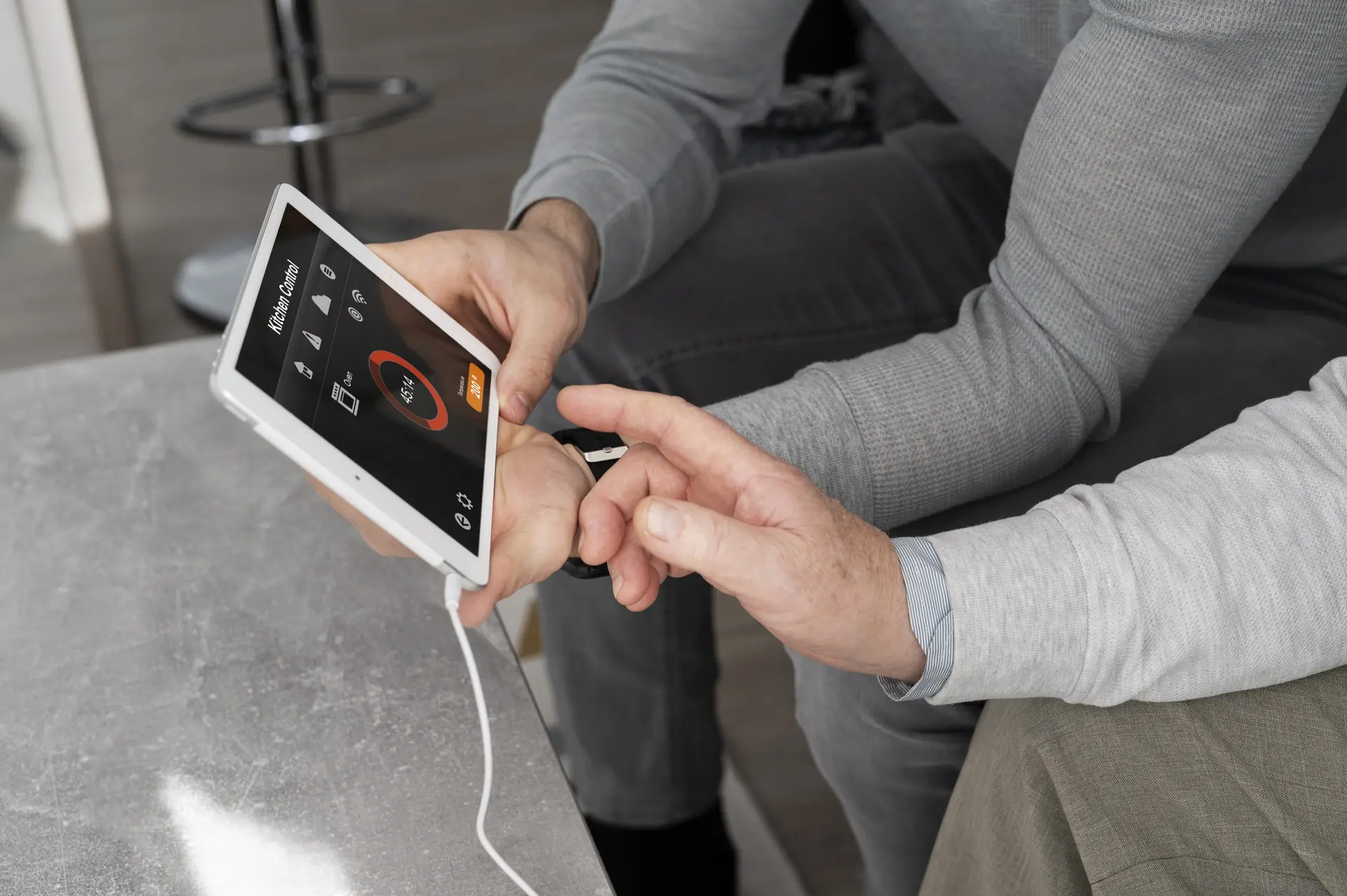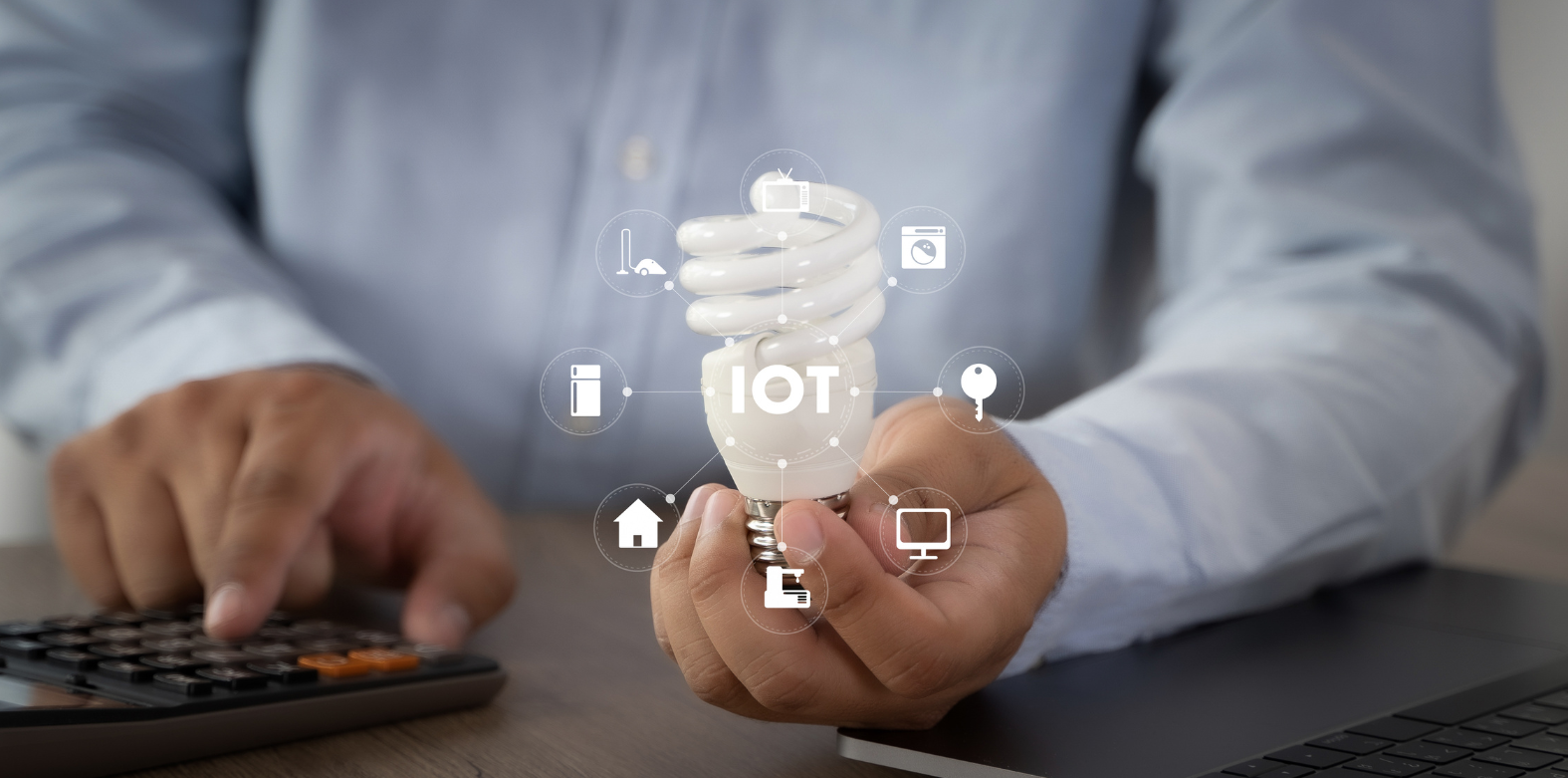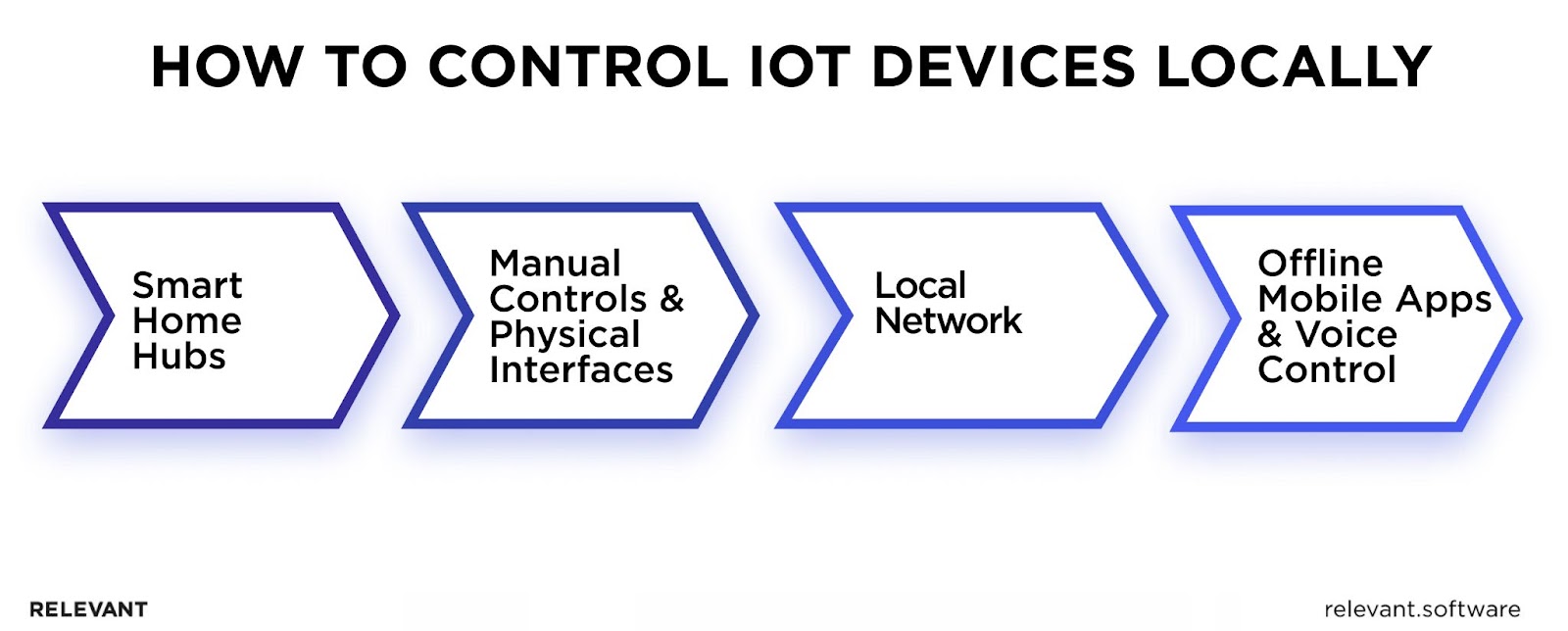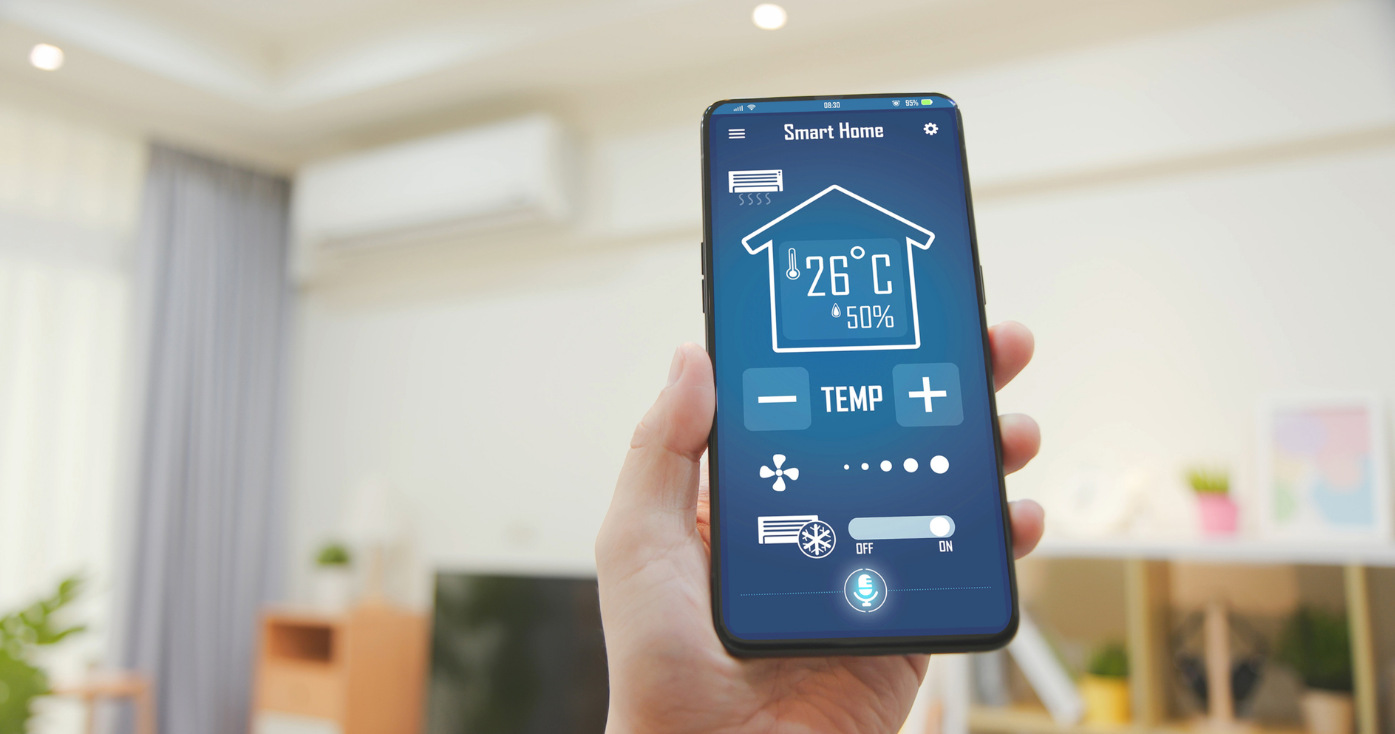How to Control IoT Devices: Both Remotely and Locally

We’ve all been there: faced with new technology and feeling lost. When it comes to managing IoT (Internet of Things), it’s easy to feel overwhelmed. But trust us, with a bit of guidance, a grasp on how to control IoT devices will be no harder than learning the ins and outs of a new smartphone.
This isn’t a technical manual that’ll gather dust on your shelf. It’s a friendly walkthrough for everyone, whether you’re just curious about that new smart thermostat or you’re implementing the latest tech in your business. Here, we’ll share IoT control options to help you make the most of your smart devices.
Let’s start with the basics, and soon enough, you’ll be more than just familiar with IoT device management — you’ll be in control.
The Anatomy of IoT Devices
To truly comprehend the workings of IoT, it’s important to focus on two primary components facilitating seamless online interactions:
IoT Sensors
These are the workhorses of the IoT world, often referred to as end devices, nodes, or physical devices. They’re adept at detecting a range of physical occurrences – think temperature, pressure, motion, humidity, or smoke detection. As new industries embrace IoT, the variety and scope of sensors continue to grow.
Typically, sensors transmit their data wirelessly and at regular intervals. They’re designed to be cost-effective, durable, self-sufficient, and tailored for specific tasks. Given their small size and these requirements, direct internet connectivity for each sensor isn’t usually feasible or economical. Hence, they’re often paired with another set of devices for connectivity.

IoT Connectivity Devices
Think of these as the communicators in the IoT ecosystem, similar to gateways or routers. They bridge the gap between the sensors and the Internet. These devices can gather data from sensors via Bluetooth or use other protocols designed for IoT connectivity, like LoRaWAN® and Sigfox.
The role of these gateway devices is multifaceted. They collect data from sensors, package it, sometimes preprocess it, and then relay it to a web server for further processing. This process can lead to various outcomes, such as computing statistics, triggering specific actions (like activating an irrigation system), or sending alerts in emergencies.
A single connectivity device can interact with thousands of sensors, which is why their design focuses on adaptability, independence, and reliability. Equipped with greater computational power than a sensor, they can also be managed remotely over the Internet. This can include a SIM card, Ethernet, or Wi-Fi connection. Naturally, these added capabilities mean connectivity devices generally cost more than individual sensors.
In the sections to follow, we’re going to dive into how you can take the reins of these devices. We’ll talk about different ways to control them, why keeping them secure matters, and how they’re changing the way we interact with the world around us.
How to Control IoT Devices Remotely
Let’s take a practical look at remote control options for IoT devices.
Native Mobile Apps
Most IoT devices are paired with specific apps that you can easily install on your smartphone. Once you’ve got the app, you’re granted the ability to adjust device settings, monitor their data outputs, receive timely notifications, and even remotely update your software — all from virtually any location, as long as you’re connected to the Internet.
Now, diving a bit deeper into the connectivity aspect, these mobile applications have underlying communication mechanisms. While some might establish direct connections using common technologies like Wi-Fi or Bluetooth, others might adopt a slightly more complex approach involving the Internet and specific application programming interfaces (APIs) that pass commands to the devices.
Voice Commands
The Internet of Things (IoT) has paved the way for new methods to manage smart devices, and voice command has become a standout. Systems like Alexa from Amazon and Google’s Assistant have popularized this concept, letting users command their devices using speech. It’s direct and frees up your hands.
Based on cutting-edge technologies like speech recognition, this approach to remotely control IoT devices lets users give orders and receive verbal feedback. For this setup, IoT gadgets need both a microphone and a speaker. They also need software that comprehends and processes spoken prompts, either inbuilt or connected to an external cloud service.
Many of these voice-responsive IoT devices can mesh well with the broader voice-operated platforms from industry leaders like Amazon, Google, or Apple. This compatibility streamlines device management, offering a unified and intuitive user experience.
Web Dashboards
Web dashboards are super handy when dealing with remote control IoT devices. You can manage everything from your browser, which is awesome because you don’t have to be next to the devices to manage them.
Think of a web dashboard as a command center for all your IoT stuff. You can see what’s happening in real-time, tweak settings, and even send commands to multiple devices simultaneously. That way, the really important stuff is right there when you open it, making things easier and faster. Then there’s the data side of things. These dashboards can track data over time, which is great for identifying trends or determining when maintenance is due.
Web Interfaces
Web interfaces are like the simpler cousins of those full-blown web dashboards. If you think of a dashboard as the whole control room buzzing with screens and data, a web interface is more like having a neat, single control panel.
These interfaces are super handy when you want to check on something or make a small adjustment quickly. Imagine you’ve got a smart thermostat at home. Instead of navigating through a complex dashboard that shows everything from your lights to your security system, you pop open a web interface specifically for your thermostat. It’s straightforward, no-frills, and gets the job done.
This simplicity is what makes web interfaces shine. You’re not bombarded with tons of information or options. It’s more about focusing on one task or device at a time. So, whether it’s adjusting the temperature, turning off a smart plug, or just checking the status of a device, a web interface is your go-to for quick and easy control.
Cloud-based Platforms
Cloud-based platforms have transformed how we manage IoT devices. Imagine having all your devices, whether they’re at your residence, workplace, or in varied places, linked to one central cloud service. This service doesn’t just store the substantial data generated by these devices; it does so securely, saving you from concerns about local storage limitations.
Beyond just storage, these platforms excel in inter-device communication. They play a pivotal role in ensuring all your gadgets, irrespective of their brand or function, communicate without a hitch. In business contexts or when juggling multiple devices, this fluid communication is vital. It’s what allows your office’s climate control to know your whereabouts or for your security setup to sync with your lighting system. With cloud technology, all these interactions are streamlined for efficiency.

How to Control IoT Devices Locally
When it comes to mastering local control of IoT devices, there’s a lot to unpack.
Smart Home Hubs
At the heart of any efficient smart home is a dependable hub. Think of it as a control center that gets your devices speaking the same language. If your camera uses Zigbee and your thermostat prefers Z-Wave, the hub makes them play nice together. Plus, thanks to the hub, your devices don’t always require the Internet. You can manage your smart home even when the Wi-Fi is napping.
Manual Controls and Physical Interfaces
Who said buttons were out of fashion? There’s something reliable about a good old switch or dial. Especially when your tech-savvy nephew decides to mess with the Wi-Fi settings. Having tactile controls means you can still dim the lights or turn up the heating even if other systems fail you. Technology has made it easy for everyone in the house.
Local Network
Connecting your devices to your local network is like keeping your family close. It’s all about communication without interference. Working on a local network, your devices communicate with each other under your roof without shouting over the World Wide Web. It’s faster, safer, and means your smart doorbell won’t be broadcasting information to the Internet every time the postman walks by.
Offline Mobile Apps and Voice Control
Have you ever tried to command your smart speaker when the Internet is down? Some apps and devices are smart enough to listen, even without Wi-Fi. With offline capabilities, these tools keep the convenience alive and control all IoT devices offline. It’s like having a well-trained pet; they’ll obey commands even when the treats (or Internet) run out.
In essence, these local control strategies for IoT devices provide you with various layers of convenience and security and ensure that your smart home remains responsive and under your control.

Steps for Remote Management of Devices
Managing devices remotely involves a series of steps to ensure efficient operation and security. Here’s a more down-to-earth breakdown of what this involves:
1. Understanding Your Needs
You need to really get what you’re dealing with. Are we talking about a couple of smart bulbs in your home, or are you setting up an entire fleet of sensors in a factory? Your approach here will vary drastically based on scale and complexity. Do you need real-time data monitoring, or is daily reporting enough? Getting this step right lays the foundation for everything else.
2. Choosing Your Management Platform Wisely
This is like picking your team’s quarterback – the platform you choose will lead your IoT management strategy. You want something that doesn’t just do the job today but can adapt as your business grows. Can it handle the number of devices you have? Does it support the communication protocols you’re using (like MQTT or CoAP)? Think of it as a long-term relationship; you want a platform that grows with you.
3. Solidifying Connectivity
This is the lifeline of your IoT system. Whether you’re using Wi-Fi, cellular, or other IoT communication protocols like LoRaWAN, the connection needs to be rock solid. Nothing’s worse than getting that “device offline” message just when you need data the most.
4. Keeping Software and Firmware Updated
It’s not the flashiest part of IoT management, but keeping your software and firmware updated is like getting a regular oil change for your car – it keeps everything running smoothly and prevents bigger problems down the road. Regular updates protect you from new security threats and ensure your devices have the latest features.
5. Remote Access Setup
Now, this is where you get the power to manage devices from anywhere. But with great power comes great responsibility. Make sure you’re not leaving a backdoor open for hackers. Proper security protocols are a must in access control IoT devices.
6. Tightening Security
Speaking of security, this is non-negotiable. We’re talking strong passwords (no more “admin123”), maybe even two-factor authentication. And please, don’t put all your devices on the same network as your guest Wi-Fi.
7. Defining User Roles
You wouldn’t give everyone in your company a key to the safe, right? It’s the same principle here. Limit who can do what with your IoT devices. This isn’t just about preventing malicious attacks; it’s also about avoiding accidental mishaps.
8. Monitoring and Maintenance
This is the equivalent of keeping an eye on the health of your IoT setup. Are the devices functioning as they should? Are there any unusual patterns in the data they’re sending? Regular check-ins can save you from major headaches down the road.
9. Having a Backup Plan
Always have a Plan B. What if a device fails? How quickly can you replace it? Is your data being backed up somewhere? Think of it as an insurance policy for your IoT system.
This approach ensures you’re not just throwing tech at a problem but are making informed, strategic decisions that will serve you well in the long run. When managed correctly, IoT devices can be a powerhouse for efficiency, insights, and innovation.

Remote Control and Management in IoT: Key Protocols Explained
In IoT development, the protocols that govern device interaction and control are vital. These protocols cater to various needs, from simple message relaying to complex, real-time data exchanges. Let’s dive into some of the prominent protocols that are shaping the way we manage and control IoT devices remotely.
- MQTT: Message Queuing Telemetry Transport, or MQTT, is a minimalistic, publish-subscribe protocol ideal for scenarios like remote sensor monitoring. You can control all IoT devices from the MQTT hub. MQTT shines in its ability to maintain stability and efficiency, even over shaky network conditions.
- CoAP: The Constrained Application Protocol, better known as CoAP, is specifically developed with the limitations of IoT devices in mind. Operating in environments where power and network resources are scarce, such as with battery-operated sensors, CoAP allows these devices to communicate effectively without draining their precious resources.
- HTTP/HTTPS: Hypertext Transfer Protocol (Secure), the bedrock of the World Wide Web, also finds its application in the IoT space. Its role becomes crucial when IoT devices need to engage with web-based applications or cloud services, providing a familiar and reliable means of data exchange.
- AMQP: Advanced Message Queuing Protocol, or AMQP, takes the principles of MQTT further. It’s tailored for more complex IoT ecosystems where reliable message delivery and sophisticated queuing mechanisms are non-negotiable. AMQP is particularly valuable in environments where message integrity and order are critical.
- DDS: Data Distribution Service (DDS) is the specialist in the world of IoT protocols, catering to high-stakes, real-time applications. It’s a boon in industrial IoT setups or any scenario where lightning-fast, efficient data distribution is key to operational success.
Each of these protocols plays a specific role in the diverse and expanding landscape of IoT. Understanding and selecting the right protocol for a given application is crucial in harnessing the true potential of IoT devices, ensuring seamless communication and effective remote control and management.
How to Control IoT Devices: A Focus on Safety and Privacy
Ways to control IoT devices remotely highlight technical aspects intertwined with vital security and privacy considerations. As an IoT development company deeply immersed in this domain, we can stress the importance of a methodical approach to ensure the resilience and dependability of IoT systems.
Pinpointing IoT Security Risks
Understanding IoT security starts by recognizing the specific vulnerabilities:
- Initial Device Settings: Most IoT devices are set up for easy installation, sometimes at the expense of security. Adapting these settings is a foundational step towards robustness.
- Staying Current with Software: Devices with outdated software are potential targets. Consistent firmware updates serve as a defense mechanism, rectifying identified vulnerabilities.
- Solidifying Network Foundations: A secure network is fundamental to IoT. Implementing high-quality encryption and, if possible, separating the network can limit the impact of potential hacks.
- Guarded Data Exchanges: Within IoT, data is transmitted continuously. Providing end-to-end encryption both in transit and at rest is critical.
Prudent IoT Device Management
Securing devices goes hand in hand with employing rigorous measures:
- Stringent Password Protocols: Opt for sophisticated passwords and renew them periodically. Bypassing common pitfalls, such as simplistic or default passwords, is crucial.
- Adoption of Two-Factor Authentication: 2FA goes beyond an added security tier; it’s a fundamental component in confirming user identities.
- IoT-Focused Networks: Dedicating a separate network to IoT devices can act as a buffer, isolating them from broader network vulnerabilities.
- Ongoing Surveillance and Review: Regularly inspect network activity and device behaviors. This proactive stance aids in early anomaly detection.
Upholding Privacy in IoT Implementations
Privacy goes beyond simple regulatory compliance; it’s about ensuring and strengthening user trust:
- Clear Data Handling Protocols: Transparency makes it crystal clear to users what’s happening with their data at every step – from collection to storage. It’s about ensuring users are never in the dark.
- Privacy as a Priority: Embedding privacy isn’t just ticking a box; it’s about creating a fortress around user data.
- Regular Privacy Health Checks: This ongoing vigilance means your data protection is always up to speed.
In conclusion, efficient management of IoT devices requires a combination of technical skills and an in-depth understanding of current safety and privacy standards. Such a comprehensive approach guarantees not only the functionality of the systems but also their reliability and customization to meet clients’ operational needs.
How to Control IoT Devices: Bottom Line
In the IoT arena, no concept is too niche, and no vision is too bold. Our ethos is grounded in the belief that IoT is a versatile tool, an enabler that can transform any business, from the unique challenges of IoMT solutions in healthcare to the precision-required IoT systems of energy. Here’s what sets us apart:
- Bespoke IoT Architecture Design: We don’t just build IoT solutions; we craft them to fit like a glove around the unique contours of your business operations.
- Device-specific IoT Protocols: We specialize in a custom-fit IoT protocol that sings in harmony with each of your devices, ensuring efficiency and productivity.
- Cloud Application Creation: The cloud isn’t just another platform; it’s your new operational horizon. Our expertise lies in developing cloud applications that aren’t just robust but are the backbone of your scalable, flexible, and secure operations.
- IoT Connectivity & Gateways: We don’t just connect your devices; we ensure they communicate in the most optimized manner possible, turning your IoT network into a conduit of seamless productivity.
- Embedded IoT Client Design: We get down to the brass tacks, engineering IoT clients that are embedded not just in your systems but are a fundamental part of your operational DNA.
With Relevant, you step into an IoT-driven future that’s not just about adapting to change but defining it. Contact us!



